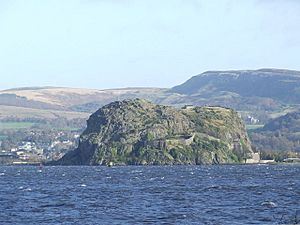Siege of Dumbarton facts for kids
Quick facts for kids Siege of Dumbarton |
|||||||
|---|---|---|---|---|---|---|---|
| Part of Viking attacks in Scotland | |||||||
 View of Dumbarton Rock from across the River Clyde |
|||||||
|
|||||||
| Belligerents | |||||||
| Britons of Strathclyde | Vikings from Dublin | ||||||
| Commanders and leaders | |||||||
| Arthgal ap Dyfnwal | Ivar the Boneless Olaf |
||||||
The Siege of Dumbarton was a big battle that happened in 870. Viking leaders named Amlaíb and Ímar attacked the strong British fortress at Dumbarton Rock. This fortress was the capital city of the Kingdom of Alt Clut, which was the only British kingdom left outside of Wales.
The Vikings wanted to capture Dumbarton because it was a very important place. They likely wanted its treasures and to stop Alt Clut from being a strong power on the sea. The siege lasted for four months, which was a very long time for Viking battles. The people inside the fortress finally gave up because they ran out of water.
After the Vikings won, many people from Dumbarton were taken away. The capital city of Alt Clut then moved to a place called Govan, and the kingdom became known as the Kingdom of Strathclyde. Losing Dumbarton made the kingdom weaker, and it started to be influenced more by the Scottish Kingdom of Alba.
Contents
What Was Dumbarton Like Before the Siege?
After the Anglo-Saxon people came to Britain, the Kingdom of Alt Clut was the only British kingdom that was not in Wales. In 870, Arthgal ap Dyfnwal was its ruler.
For most of the 800s, Alt Clut had avoided the worst of the Viking attacks. By 870, the town on Dumbarton Rock was the center of a small but rich kingdom. The rock was in a very important spot, right where the Clyde and Leven rivers met. If Vikings controlled Dumbarton, they could sail further upriver into the middle of Scotland.
Dumbarton Rock was also a very strong place to defend. It had survived many attacks before, even a big one by the Angles and Picts in 756.
Why Did the Vikings Attack Dumbarton?
After winning battles in England, including taking York in 866, Ímar joined forces with Amlaíb, who was the Scandinavian King of Dublin. They decided to attack Dumbarton, a wealthy town.
Besides wanting to take valuable things, the Vikings might have wanted to stop the Britons from being a strong sea power. No other Viking campaign by Ímar and Amlaíb involved such a long attack on one place. This shows how powerful Alt Clut still was at that time.
How Did the Siege Happen?
In 870, Amlaíb and Ímar brought their armies together and attacked Dumbarton. They could not take the fortress right away, so they surrounded the rock for four months. This was a very unusual amount of time for a Viking siege in Britain. The people defending the fortress held out for four months until their well dried up. Without water, they had to give up.
Old stories from Wales say that the top of Dumbarton Rock was destroyed. Some historians think that after a long siege, the Viking attackers might have captured the lower part of the rock where the well was. This would have forced the defenders to go to the highest part without any water. Once the siege was over, the Vikings took everything valuable from the fortress and captured many of the defenders.
What Happened After the Siege?
Records from the time say that after the siege, a fleet of 200 ships took the captured people to Dublin. Other prisoners, including Picts, Scots, and Northumbrians, who had been captured in earlier Viking raids, were also on these ships. Dublin was a major market for selling people at that time.
After Alt Clut's main fortress was lost, the kingdom's center moved about 12 miles (19 km) upriver to Govan. Dumbarton Rock might have become a Viking base for a while. After this move, the kingdom became known as the Kingdom of Strathclyde.
It's possible that Arthgal, the king, escaped the siege and went to Pictland for safety. Or he might have been one of the prisoners taken to Dublin. In 872, Arthgal was killed. Some think this happened because Constantine I of Scotland suggested it.
The kingdom was much weaker after the siege. Its main fortress was destroyed, and its government was in trouble. Some Viking-style ruins found in the Clyde area suggest that the fall of Dumbarton led to more Viking influence and settlement in the area. It is likely that Strathclyde started to come under the control of Alba during this time.
However, Strathclyde was still an independent kingdom in battles and royal records until sometime in the 11th century. It then joined Alba peacefully. The local Cumbric culture, which was the way of life for the people there, slowly disappeared by around 1300.
Arthgal's son, Rhun ab Arthgal, became the King of Strathclyde after his father's death. Rhun likely ruled under Constantine, who was his brother-in-law. This might explain why Arthgal was killed.
Images for kids


